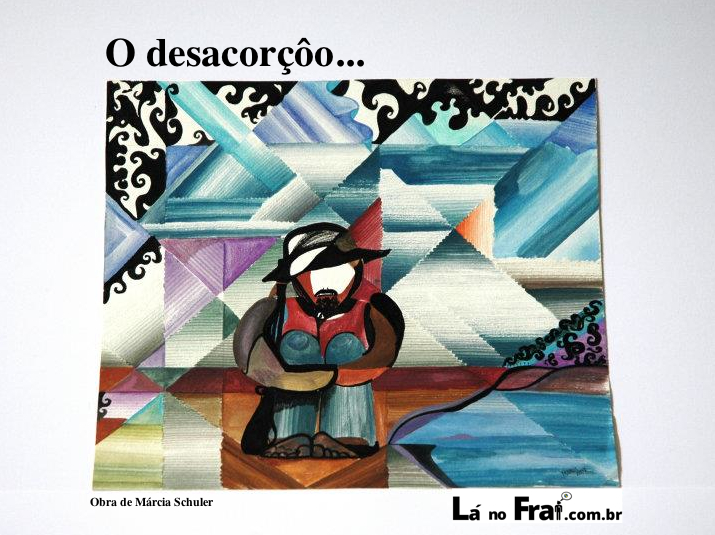Foto histórica de Fraiburgo – Quem imaginaria que tudo poderia mudar tão rápido? Qual seria o impacto no inconsciente coletivo das pessoas que por muitos anos eram recepcionadas pelos túneis de árvores?
Trabalho de Iole Dahmer
Caros leitchôres,
Como muitos de vocês já devem saber, os tchôzinhos(as) do Frai não desanimam fácil nem ficam tristes, eles apenas entram em processo de desacorcoamento, fato este, que pode variar em gênero e grau e afeta a todos invariavelmente. Nesse sentido a artista Márcia Schuler de Videira (zona oeste da grande Fraibugo) conseguiu representar, em aquarela, o sentimento de desacorçoamento dos tchô do contestado no seu sentido mais profundo, tendo como inspiração a humilhação tchozina na guerra do contestado que resultou na mutilação do tecido social brasileiro que se formava nessa região há quase 100 anos. Foi uma gerra onde brasileiros mataram brasileiros motivados pelo pelo capital americano interessado em passar os trilhos por SC, retirar os milhões de pinheiros, e vender a terra loteada aos europeus esfomeados que aqui não paravam de chegar e hoje ajudam a formar esse caldeirão multi-étnico que é a grade Fraiburgo. Obrigado à Márcia por compartilhá-la de forma digital e por nos ajudar remontar um pouco dos cacos da nossa história…
Dear international reader,
As you probably don’t know, in our Fraiburguese dialect we, sometimes, make use of interesting expressions with a strong meaning for sadness which is a thing that affects all human beings without exception. In this sense the artist Marcia Schuler from Videira (west of the great Fraibugo’s metropolitan area) depicted, in watercolor, this feeling during that was more acute I would say after the contested war that took place in the region around 100 yeas ago when the locals (Brazilians) got killed and humiliated by other Brazilians defending the interests of an American Railway company that wanted the put the rails, get the land and millions of pine trees.

Pés descalços, cores indefinidas, assimetrias, cabeça baixa e o chapel tchozino virado para sua direita.
–
Um dia foi assim, o sol nasceu, os pinheiros mergulharam no lago sem se molhar e as cores se despertaram. Tudo no seu tempo, tudo no seu espaço, tudo em Fraiburgo, terra do lago das Araucárias…
That was the way sun appeared, the pine trees dry-dived in the lake and the colours woke up. Each thing in each own time, space in Fraiburgo, the land of the Araucárias lake.
Impossível passar pelo Frai sem notar as remanescentes e imponentes araucárias e suas fieis amigas cortejantes (hortências). O que me alegra é poder vê-las ainda ao vivo e das suas grimpas fazer um fogo de chão que estrala como pipoca para sapecar o pinhão.
Impossible to pass by without noticing the remaining and imponent Araucária pines and their faithful friends (hydrangeas). I’m glad they still exist provinding delicius food (seeds) called “pinhão”.
Por muito pouco nossas araucárias não foram todas extintas. Em menos de 50 anos elas foram perseguidas e aniquiladas sistematicamente num tremendo holocausto vegetal sem precedentes na nossa história. Quanto maior fosse a tora, maior era o orgulho da ignorância do homem. A americana Southern Brazil Lumber & Colonization Company era como um polvo e seus tentáculos (trilhos) penetravam no continente sugando todas as árvores e recursos naturais que poderiam ser transportados nos vagões até os portos de SP e RJ. Onde estariam essas árvores hoje? Depois da limpeza no terreno, bastava expulsar os nativos da região e vender terrenos já loteados para os europeus famintos que, no Brasil, não paravam de chegar.
Resultado,
a desabilitada estrada de ferro do planto nos custou o “despovoamento de 15 milhões de pinheiros, imbuias, cedros e perobas que se aninharam no extenso planalto de Canoinhas” Sergio Sachet – Santa Catarina 100 de história. Do gene humano que ali habitava o estrago foi incalculável.
It is just by chance they were not all extinguished. In less than 50 years they were systematically persecuted and annihilated a huge vegetable holocaust unprecedented in our history. The larger the log, the greater was the pride of ignorance of human kind. The U.S. Southern Brazil Lumber & Colonization Company was like an octopus and the tentacles (rails) penetrated the continent sucking all the trees and natural resources that could be transported in wagons to the ports of RJ and SP. Where were these trees today? After cleaning the ground, it was enough to expel the natives and sell land already batched for the hungry Europeans immigrants who could not stop coming to Brazil.
As a result,
The, nowadays, a disabled railroad costed the “depopulation of 15 million pines, walnuts, cedars and perobas that nested themselves in the extensive plateau Canoinhas” Sergio Sachet – Santa Catarina 100 history. Regarding the the human gene that lived there the damage was incalculable.